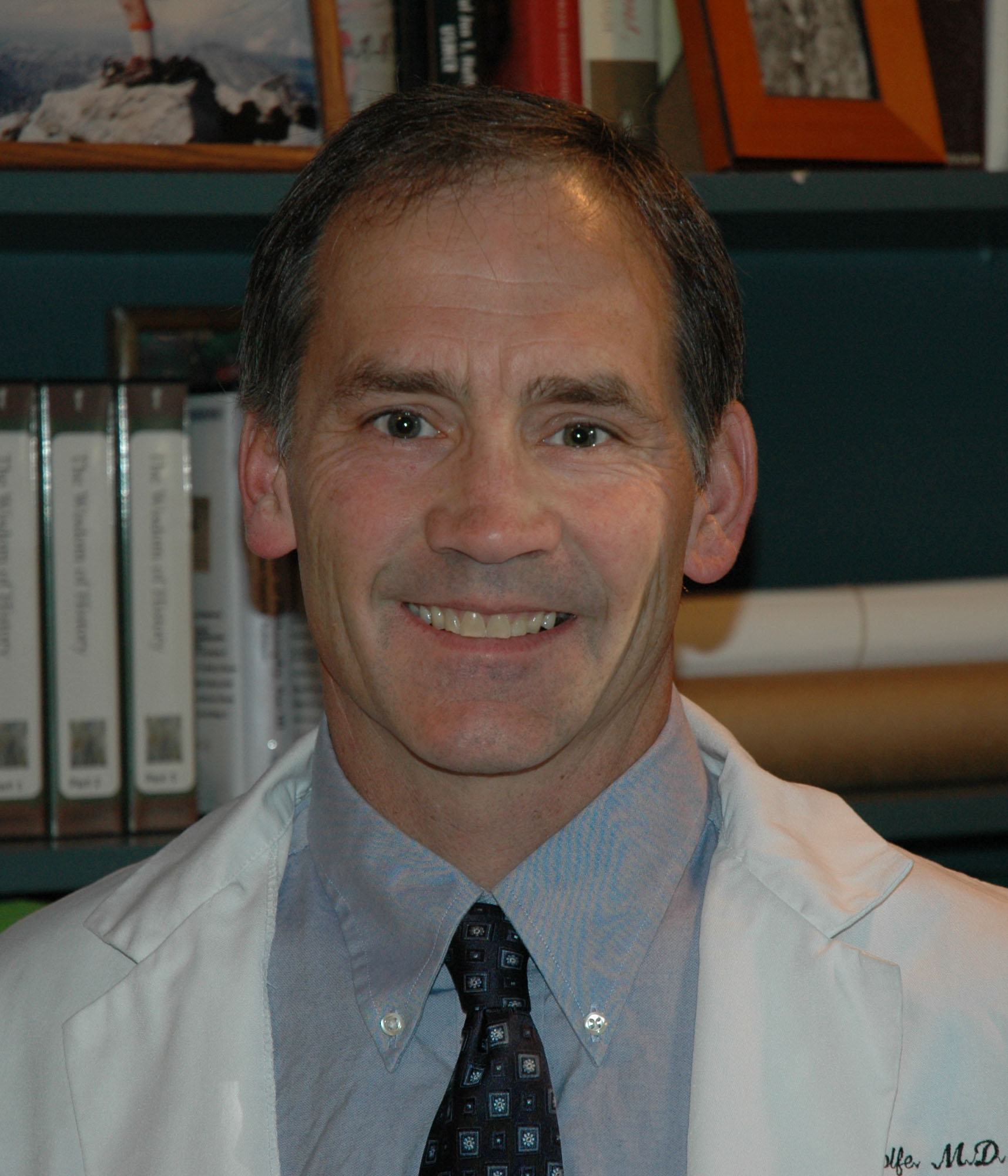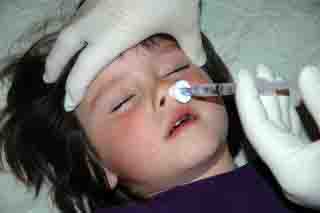Informational Links Related to Intranasal medication delivery
CONTACT INFORMATION for specific questions not addressed on this web site:
E-mail address - info@intranasal.net
(Be aware that I am usually busy caring for patients, spending time with my kids or climbing mountains and only check this e-mail during the times I update the site - about every 4 to 6 weeks. So if you are in a hurry you may be disappointed)
History behind this web site:
The primary author of this site, Tim Wolfe MD, is a practicing emergency physician with a background in EMS. Some of his physician and paramedic colleagues also assist with the writing of this site and many contribute clinical insights.

He trained in a medically underserved county hospital during the onset of the HIV epidemic in the 1980's where he noticed that many of his patients were able to "safely" self medicate using elicit drugs without needles - they used a form of nasal drug delivery called snorting. This concept led him to test the efficacy of having his patients "snort" inexpensive generic medicines (by dripping it in their noses) in hopes of finding both a safe and a painless method of drug delivery for paramedics and ER nurses (who at that time were seroconverting to HCV and sometime HIV simply for doing their jobs). Unfortunately his clinical experience was mixed - sometimes nasally delivered drugs were very effective, other times not so effective. His epiphany occurred in the middle of the night while dripping a measured dose of a benzodiazepine into a child's nose - the child spit it back in his face. At that moment he realized that he was giving ORAL drugs via the nose which probably explained the variable efficacy he had noticed all along. He needed to change the mode of delivery. If there was only a way to rapidly aerosolize an exact dose of the drug into a fine mist that could be delivered directly to the nasal mucosal with no loss into the environment (nebulization does not achieve these needs since most is not delivered to the nose or to the lung, rather is it lost to the environment, takes time to deliver and usually requires a compliant patient). Through trial and error using compressed air, dual syringes, etc the idea morphed into a very simple syringe driven atomizer. He and a friend started a company selling that device (the MAD - mucosal atomization device).
In 2010 the company was sold and Dr. Wolfe currently receives no royalty nor any money from the MAD. However, Dr. Wolfe consults for interested device and pharmaceutical companies and in 2021 began consulting for Pulmodyne who manufactures a new mucosal atomization device called the DART for which he receives a small royalty. He does not have shares in these companies nor do they have any control of this web site. Never the less an author can never completely remove his or her bias from any writings and you will find that Dr. Wolfe feels strongly that nasal drug delivery is a valuable drug delivery adjunct to providing efficient and effective patient care. Furthermore due to his training in a poor, medically underserved community you will find a bias towards using inexpensive generic drugs that are proven by the literature to be clinically effective (rather than focusing on drug levels and bioavailability which do not necessarily translate into clinical effect when applied in the real world - case in point the tiny 0.1 ml volumes that supposedly work via the nose of compliant patients but are extremely difficult to administer in the ER setting). Since the MAD and the DART are commonly used in these research studies there is also a great deal of literature that involves those products so a bias could be suggested here as well.
Because he gets questions from clinicians and patients all over the world and because he enjoys teaching about the topic he and some colleagues created this site to help provide a place for the curious clinician seeking detailed information. He apologizes for the somewhat disorganized look of this site - he is just a doctor, not a web master. Someday when he has the time he may re-write the site to make it less cluttered. If you personally want to communicate with him feel free to do so via the email address above providing your name and affiliations and he will eventually respond.
Note from a Fellow EMS director, emergency physician:
January 14, 2010
Dear Tim,
I am offering this little note to share with you some thoughts regarding
the importance of mucosal administration in the care of our patients. It
is clear to us in the fields of emergency medicine and EMS medicine that
we have had a long neglected opportunity for care. You have brought this
advance to the forefront. You saw clearly that through a novel yet
simple idea, we could garner a new advantage that had long been missing
in clinical care. Because of your insight, we can now approach many of
the long‐dealt‐with dilemmas in emergency care that before often eluded
us, indeed caused us to offer in many cases less than optimal care.
One important example is in the treatment of seizures. Those of us who
have dealt with pediatric patients suffering from convulsions for
example, in the absence of intravenous access, have been left with
virtually no other alternative than the per rectum administration of
diazepam to halt the seizure. You gathered the budding information in
the literature and quickly adapted an invention that could simply,
safely treat this difficult problem in a much more proper, much less
toxic manner. This has been a great advance in the history of medicine.
Respectfully,
Raymond L. Fowler, MD, FACEP
Professor of Emergency Medicine
Chief of EMS Operations
Southwestern Medical Center at Dallas
Attending Emergency Medicine Faculty
Parkland Memorial Hospital
INTERNET DISCUSSIONS regarding IN therapy
Reviews
Pain discussions
- Intranasal fentanyl relieves breakthrough cancer pain
- Industry sponsored discussion of intranasal pain medications
- Intranasal fentanyl or intravenous morphine for analgesia in adults - Best Bets evidence based topic review.
- Intranasal Fentanyl versus parenteral opiates for acute pain in children - Best Bets evidence based topic review.
- Prommer et al, Intranasal fentanyl review article 2011
- Stay on top of kids pain in the ED (use IN fentanyl) - ACEP news December 2010
EMS links of interest
-
The Nose Knows - cost effectiveness of transnasal therapy
- Australian Lay public education regarding treating seizures, calling 112 and using intranasal midazolam (PDF 0.2 MB)
- New South Wales EMS protocol for pediatric seizures (PDF 0.17 MB)
- Audio interview with Debra Kerr - IN naloxone researcher
- Contra Costa EMS update 2010 (Intranasal naloxone pp 38-50)
- Intranasal fentanyl use in ski resort
- Inhaled methoxyflurane vs intranasal fentanyl for adult visceral pain in an ambulance
- Dyer, Snuffing out the overdose: The Boston BLS nasal naloxone program slide presentation (11 MB)
- Intranasal Versed usage - Paramedic perception of Utility in urban EMS system (Columbus OH)
- Use of IN naloxone by ALS and BLS providers in Boston MA
- National public radio - Overdose rescue kits save lives
- Chris Colwell, MD - The Nose Knows: Intranasal Medications options are growing (Gathering of Eagles EMS conference feb 2011)
- Excited Delirium in EMS - treatment with IN midazolam, Emergency Medicine News October 2010
- Prepackaged syringes of drug ready for use with an atomizer - cool idea
- Intranasal naloxone as a layperson administered procedure - the Massachusetts experience
- Intranasal fentanyl in EMS discussion (Editorial comment - the dose is too low - 1.5 to 2 mcg/kg should be used as initial dose. If you only give an adult 75 mcg you can expect it to fail so don't make this common error. Since this publication, the author has convinced his medical control of the right dose and now uses that shown to be effective on this web site.)
- Callopy and Snyder, Intranasal drug delivery in EMS. EMS today May 2011
Hospice links of interest
- Palliative info web site by Mike Harlos, MD
- Lecture slides by Dr. Portenoy (Beth Isreal) regarding breakthrough Pain in hospice patients
- www.palliativedrugs.com
Sedation discussions
- Another very detailed link discussing IN Precedex for pediatric sedation in multiple settings in the hospital
- Excited Delirium in EMS - treatment with IN midazolam, Emergency Medicine News October 2010
POSTED INTERNET ARTICLES (to go to peer reviewed articles for more PDF and web linked articles - click here)
Nose Brain Pathway articles
Pain Articles
- Industry sponsored articles in nasal pain medications
- Borland, IN fentanyl vs IV morphine for fractures in children randomized controlled trial, Ann Emerg Med 2007
- Sitte, IN fentanyl for episodic breathlessness, J pain sym manage 2008
- Rickard, IN fentanyl vs IV morphine for fractures in the prehospital setting, 2008
- Heshmati, IN sufentanil for postoperative pain, IJPT 2006
- Wilson, IN diamorphine for pediatric analgesia, J Accid EM 1998
Sedation articles
- Bkakta, IN midazolam for preoperative sedation, Ind J Anaesth 2007
- Mathai, Preanesthetic sedation of preschool children: Comparison of intranasal midazolam versus oral promethazine. Anesth Essays Res 2011.
Seizure articles
- Lahat, IN midazolam vs IV diazepam for pediatric seizures, BMJ 2000
- Ma, Clinical Guidelines on Management of Prolonged Seizures, HK J Paediatrics 2010
- Klein-Kremer, IN midazolam for treating seizures in children in the emergency setting. Is J Med 2007
- French JA.. Benzo vs Benzo: And the winner is.. Epilepsy Curr 2011;11(5):143-144.
Intranasal Naloxone articles
- Barton, IN naloxone as a needleless alternative to treatment of opioid overdose in the prehospital setting, J Emerg Med 2005
- MMWR Feb 17 2012 - Community based opioid overdose prevention programs providing naloxone - United States 2010
- Time Magazine - Lifesaving Overdose antidote should be made more widely available 2012 article
- Time Magazine - Lifesaving Overdose antidote should be made more widely available 2012 editorial
Topical anesthetic articles
- A guidance for the use of topical anesthetics for nasal/oropharyngeal and laryngotracheal procedures
- Chan, Lidocaine spray prior to NGT placement, Hong Kong Medical Journal 2010
- Whit Fisher, MD Procedurettes - how to create a NGT frozen curve to enhance passage through nose - link to video
Pediatric reviews
INTRANASAL DRUG DELIVERY REVIEWS AND MISC
- References for incident pain and incident dyspnea protocol
- Pires, Intranasal drug delivery - How, why, what for -extensive review, J Pharm Pharmaceut Sci 2009
- Mercus, Influence of head position and anatomy on nasal drug deposition, Rhinology 2006.pdf
INTERNET PROTOCOLS
- Intranasal diamorphine dosing table
- Sunshine Hospital emergency department pediatric IN fentanyl protocol
- Princess Margaret Hospital educational information for parents after administration of IN fentanyl in the operating theatre
- Royal Children's Hospital Melbourne Australia intranasal pain treatment clinical practice guideline
Nasal Drug Compounding Pharmacies
Hospice links
OTHER SITES OF INTEREST
 Therapeutic
Intranasal Drug Delivery
Therapeutic
Intranasal Drug Delivery